“I’m late, I’m late for a very important date. No time to say hello goodbye! I’m late I’m late I’m late!”
Alice’s adventures in wonderland began following the white rabbit into the rabbit hole. I hope that you will follow me into this strange world through the looking glass and down the rabbit hole of Beatles mysteries into Pepperland, the place where nothing is real and synchronicity is the queen of the lonely hearts.
Returning to Sgt. Pepper’s Lonely Heart Club Band, and the constant Beatles post-67 references to this album- there seems to be a lingering fascination with Lewis Carroll and his infamous classics, Alice’s Adventures in Wonderland and Through the Looking Glass. Let’s start with the introduction of this article, and the introduction of Alice to Wonderland.
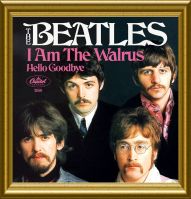 The single “Hello Goodbye” was released in November 1967 backed with “I Am The Walrus” B side. The music video for “Hello Goodbye” by the Beatles was recorded for the Ed Sullivan Show and featured all four Beatles in their Sgt. pepper costumes. This was the only time the band was pictured performing in these suits. (Jann Haworth designed the Sgt. Pepper costumes, as well as the costumes for Kenneth Anger’s “Lucifer Rising”). Although Hello Goodbye is not on the Sgt. pepper album, the boys are once again drawing our attention back to Sgt. Pepper- and their “alternate egos”. Why is Sgt. pepper so seemingly important? Is there something there that was missed? Well, I think you know my answer to this question. A resounding YES. What exactly was missed by the adoring fans is still up for debate. Perhaps this single release provides more clues to the enigma.
The single “Hello Goodbye” was released in November 1967 backed with “I Am The Walrus” B side. The music video for “Hello Goodbye” by the Beatles was recorded for the Ed Sullivan Show and featured all four Beatles in their Sgt. pepper costumes. This was the only time the band was pictured performing in these suits. (Jann Haworth designed the Sgt. Pepper costumes, as well as the costumes for Kenneth Anger’s “Lucifer Rising”). Although Hello Goodbye is not on the Sgt. pepper album, the boys are once again drawing our attention back to Sgt. Pepper- and their “alternate egos”. Why is Sgt. pepper so seemingly important? Is there something there that was missed? Well, I think you know my answer to this question. A resounding YES. What exactly was missed by the adoring fans is still up for debate. Perhaps this single release provides more clues to the enigma.
“Talking in the 1990s to his official biographer, Barry Miles, McCartney said that the lyrics address duality, reflecting his astrological sign of Gemini. He added: “It’s such a deep theme in the universe, duality – man woman, black white, ebony ivory, high low, right wrong, up down, hello goodbye – that it was a very easy song to write.” McCartney also said that, in “Hello, Goodbye”, he was promoting “the more positive side of the duality”.
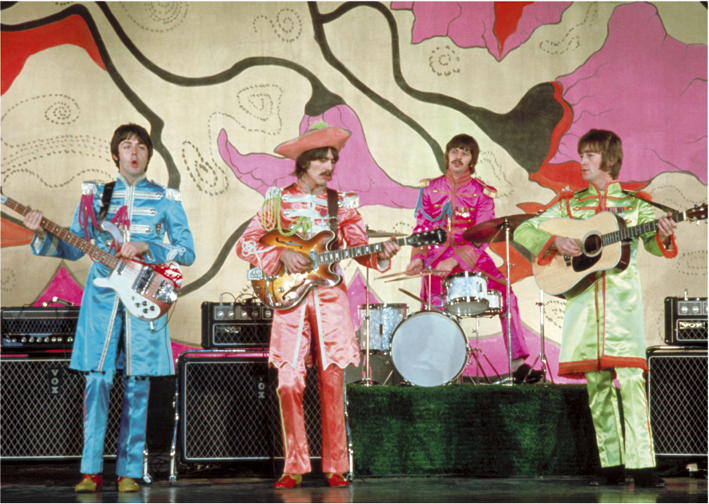
“Promoting the more positive side of the duality” or the White Rabbit, as I like to interpret this. The white rabbit could be symbolizing the adept, or the liaison guide to the underworld. Also a symbol of the spiritual awakening, or new life. Alice (name meaning “truth”) has a huge struggle with duality within her wonderland adventures. Many researchers and great thinkers of the last century have gone to great depths decoding the allagory and symbolism of Lewis Carrol’s surreal masterpiece. Well associated with the occult, Carroll attempts to tell another story within the surface story and we are left with layer upon layer of symbolism and metaphor…. Or as I like to call- The glass onion effect.
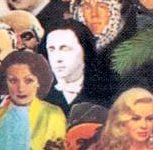
Not unlike the glass onion enigma of Sgt. Pepper’s surrealist album cover.
Lewis Carroll (real name; Charles Lutwidge Dodgson) had a great interest in the occult and in particular, Rosicrucianism and in what is sometimes referred to as the ‘Ancient Wisdom’. Hence, we have in both Alice and Through the Looking Glass as a literary outworking of the archetypal story of the hero or initiate’s journey (Alice), as well as the Gnostic redeemer myth (The Fall of Sophia), and the allegory of the descent ( the involution) and ascent ( the evolution) of the human soul. Carroll first recited the tale of Alice in Wonderland (originally titled Alice in the underground) while traversing the the Thames River through a particular section known as ‘The Isis’. The stories seem to portray esoterically Alice as an initiate, finding her way through the nonsense and chaos to ultimately achieve self-awareness and transformation.
Just as Carroll was influenced by the occult when writing this great work, the occult has been majorly influenced by Carroll’s writings since. Not to mention modern art and culture. Many researchers have pointed to the symbolism in Alice’s adventures being used in some MKUltra and/or Monarch programming. It has been said that Aleister Crowley required his magicians to read both ‘Alice in Wonderland’ and ‘Through a Looking Glass’. With that being said, it may come of no surprise then that the Beatles sought to include some of Carroll’s symbolism within their art and music.
Before we fall deeper into this rabbit hole than the numbernineblog has fallen previously, (this is a really deep hole) let’s take a look at the B Side of the Hello Goodbye single; I Am the Walrus.
Around this time in the Beatles legend, according to the official narrative, John Lennon received a letter from a pupil whom mentioned that his English teacher was making his class analyse Beatles’ lyrics. Lennon in particular seemed apprehensive towards the scrutinizing and deconstructing of his lyrics and commented in his colorful way “let the fuckers figure this one out” in regards to the lyrical craftsmanship of I Am the Walrus. On the surface, much like Lucy in the Sky with Diamonds, I am the Walrus seems to be describing a surreal acid trip. However, once you start really breaking down the lyrics of this psychedelic wonder- the Carrollian theme becomes somewhat apparent.
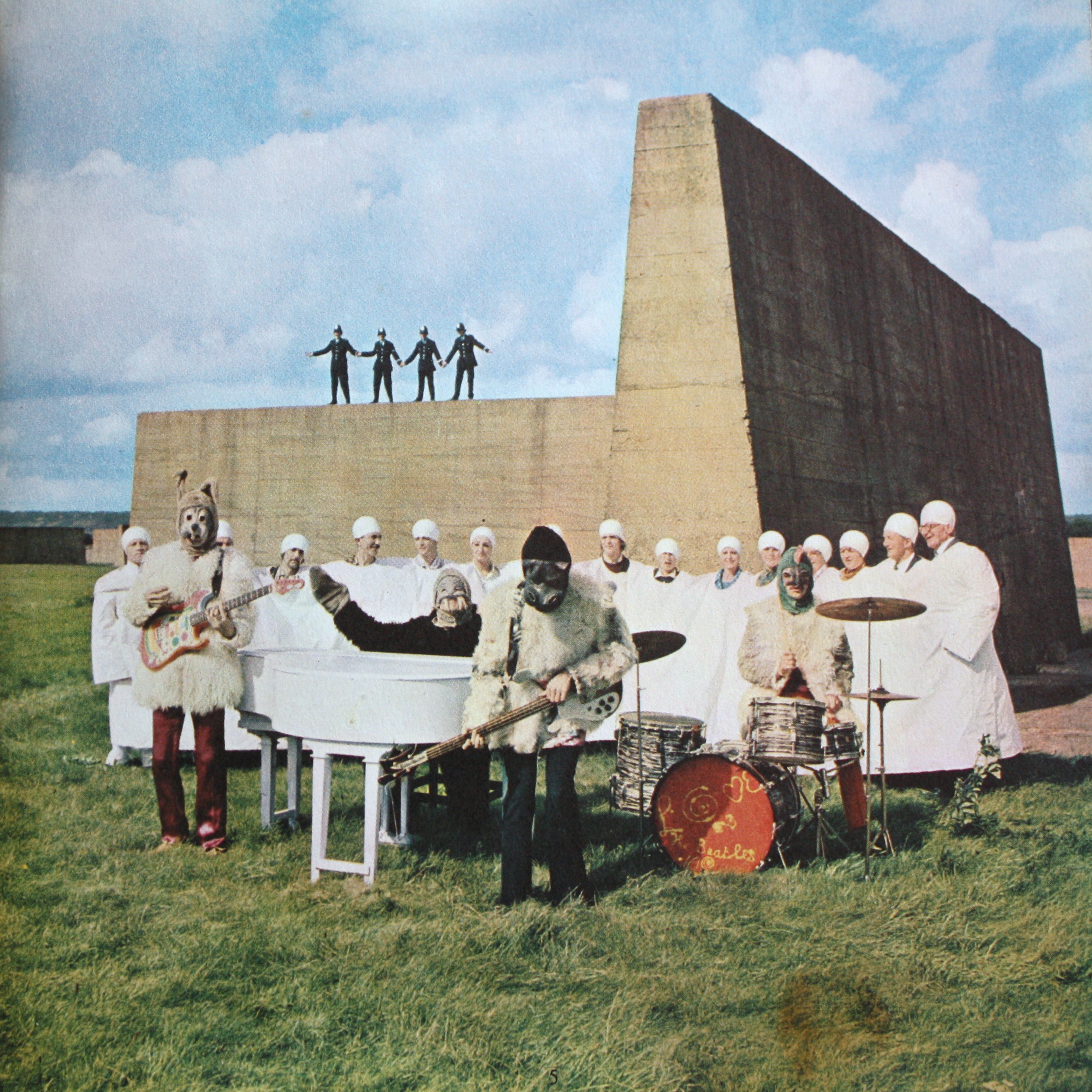
I Am the Walrus’s opening line; “I am he as you are he as you are me and we are all together” is based on the folk song “Marching To Pretoria,” a song allegedly sung by marching British troops occupying South Africa in the Boer Wars, which begins with the lyric;
“I’m with you and you’re with me and we are all together.”
Or it could also be a nod once again to Crowley who wrote:
“Let him train himself to think BACKWARDS by external means, as set forth here following:
(a) Let him learn to write BACKWARDS. . .
(b) Let him learn to walk BACKWARDS. . .
(c) Let him. . . listen to phonograph records REVERSED.
(d) Let him practice speaking BACKWARDS. . .
(e) Let him learn to read BACKWARDS. . .
(f) Instead of saying “I am he” let him say “eh ma I”(Crowley, Aleister. Magick:Liber ABA, book four, 1994 Ordo Templi Orientis edition, p. 639)
John Lennon in the now infamous 1980 playboy interview is quoted as saying:
The whole Beatle idea was to do what you want, right? To take your own responsibility, do what you want and try not to harm other people, right? DO WHAT THOU WILST, as long as it doesn’t hurt somebody…
With this information, we could ascertain that John purposely changed the lyric from “Marching to Pretoria” to Crowley’s “I Am He||Eh Ma I”. Still allowing for the symbolism of both events remain important to the overall symbolism of the song. The Boer wars allowed for the genocide of the Boer people at the hands of the British. Placing many Boer women and children in concentration camps under very poor conditions. Hundreds perished. This blog by Joeseph Atwill does a great job breaking down the song in question and its stance against(?) genocide- specifically the Boer Wars, and it’s possible ties to Revelation and the Apocalypse. It’s a FABoulous read- I highly recommend giving it a good read through. Moving forward (in reverse?) to the Carrollian themes present in the song.
In aforementioned 1980 playboy interview with Lennon, he is quoted as saying,
It never dawned on me that Lewis Carroll was commenting on the capitalist and social system. I never went into that bit about what he really meant, like people are doing with the Beatles’ work. Later, I went back and looked at it and realized that the walrus was the bad guy in the story and the carpenter was the good guy. I thought, Oh, s–t, I picked the wrong guy. I should have said, ‘I am the carpenter.’ But that wouldn’t have been the same, would it?”
The walrus and the carpenter is a poem from Through the Looking Glass. I am quite sure that Lennon is giving an intended misdirection here with his above quote. Surely he is well aware that the carpenter (usually synonymous with Jesus Christ and/or a Mason) in the poem is just as much a villain as the walrus. They both deceived and consumed all the little oysters! However, given the already well known symbolism of “The Carpenter” using the Walrus instead to symbolize the same thing as John does so well ala “the glass onion effect”. The question raised here is whether or not John purposely enjoyed deceiving the people (He claims HE is the Walrus) – or if he was warning us of the manipulation that we were facing.

It was so kind of you to come!
And you are very nice!
The Carpenter said nothing but “Cut us another slice:
I wish you were not quite so deaf–
I’ve had to ask you twice!”
“It seems a shame,” the Walrus said,
“To play them such a trick,
After we’ve brought them out so far,
And made them trot so quick!
The Carpenter said nothing but
“The butter’s spread too thick!”
“I weep for you,” the Walrus said:
“I deeply sympathize.”
With sobs and tears he sorted out
Those of the largest size,
Holding his pocket-handkerchief
Before his streaming eyes.
“O Oysters,” said the Carpenter,
“You’ve had a pleasant run!
Shall we be trotting home again?
But answer came there none–
And this was scarcely odd, because
They’d eaten every one.
“I’m crying. I’m cryyyyyyyyyyying, I’m Crying.
The ‘Backwards talking’ Crowley describes, and the Beatles use so frequently in their music could also be likened to another poem from Through the Looking Glass – ‘Jabberwocky’.
Carroll wrote:
“It was like this, ‘YKCOWREBBAJ sevot yhtils eht dna ,gillirb sawT‘ ebaw eht ni elbmig dna eryg diD ,sevogorob eht erew ysmim llA .ebargtuo shtar emom eht dnA’
She puzzled over this for some time, but at last a bright thought struck her. ‘Why, it’s a Looking-glass book, of course! And if I hold it up to a glass, the words will all go the right way again.” This was the poem that Alice read. JABBERWOCKY ‘Twas brillig, and the slithy toves Did gyre and gimble in the wabe; All mimsy were the borogoves, And the mome raths outgrabe.”
The Eggman, could be attributed to Humpty Dumpty, also from Through the Looking Glass, and who seemingly claimed to understand the Jabberwocky’s mode of communication.
Humpty Dumpty was a “master of words” or a wordsmith. John is very much like Humpty Dumpty a.k.a. the “Eggman”. Lennon’s book “In His Own Write” was very much a collection of nonsensical poetry and prose, as is the song in question. A true master of the double entendre, easily making words mean so many different things….
When I use a word,” Humpty Dumpty said, in rather a scornful tone, “it means just what I choose it to mean—neither more nor less.”
“The question is,” said Alice, “whether you can make words mean so many different things.”
“The question is,” said Humpty Dumpty, “which is to be master—that’s all.

In alchemy, the Philosopher’s Egg symbolizes the seed of spiritual life, and depicts the place wherein a great transformation takes place. To ancients in all lands, the egg was the symbol of generation and immortality. In Scandinavia and Russia clay eggs were put in tombs to ensure life after death. A similar idea was signified in ancient Egypt by the winged egg floating above the mummy, carrying the soul to another birth. Source (the great and mysterious K)
In Chapter NINE of Alice in Wonderland, we are introduced to the “Mock Turtle” character and a discussion of pepper;
“Alice was very glad to find her in such a pleasant temper, and thought to herself that perhaps it was only the pepper that had made her so savage when they met in the kitchen.”
In 1985, Ringo Starr is featured in “Alice in Wonderland” as the Mock Turtle from chapter nine.
Even little Jane Asher, Paul’s girlfriend through Beatlemania played the part of Alice in 1959, four years prior to meeting McCartney.



Just as an added antidote for this intriguing rabbit hole journey, The Walrus can be found once again on Sgt. Pepper by placing a mirror on either end of the cover. Was this intentional? Perhaps just another “crazy Beatles Coincidence” to be added to the already long list of “Beatles coincidences”.
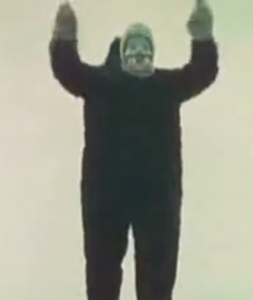
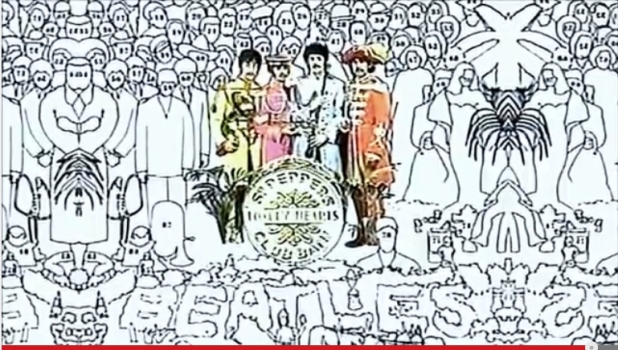
Curious to note here, is the “joker” type faces we see on the left mirrored side of the image. The first being Sonny Liston- transformed to look like a jester of sorts, and then, directly beneath his feet, a more sinister looking “fool” with horns. “Don’t you think the joker laughs at you?” This outlined mirrored image of the cover was put forth by Apple Corps. themselves, in an official version of “A Day in the Life” music video. I have also seen it used in the background images of Paul McCartney’s “Out there” tour stage set-up. Featured during his version of “Being for the Benefit of Mr. Kite”. This image was no accident- they are directly suggesting to look deeper within the Sgt. Pepper enigma. Is this what they wanted us to see??
In conclusion, I am The Walrus is one of my favorite tracks from the Beatles. The video from the Magical Mystery Tour film is just as fun and surreal as the song itself. Featuring a very odd-looking, shoe-less “Paul McCartney” and Lennon without his signature glasses, one has to wonder if perhaps we have taken a wrong turn in our rabbit-hole adventures. Perhaps we should have taken the “Walrus-hole” instead…. 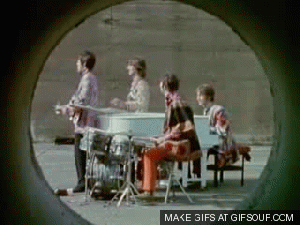
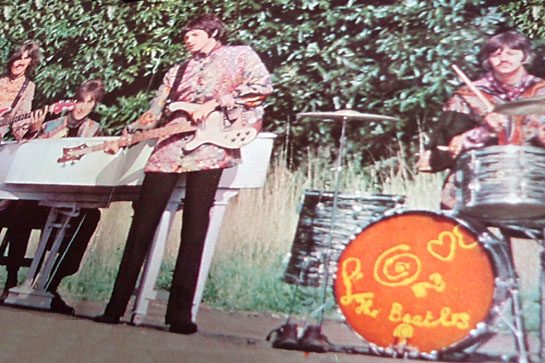 LOVE… X3 The Beatles??? or is that a mirror of IONEIX… IIIX or 3X? hmm another odd drum skin message. (the image below is taken from Page 13 of the Magical Mystery Tour Booklet or in Roman numerals page XIII)
LOVE… X3 The Beatles??? or is that a mirror of IONEIX… IIIX or 3X? hmm another odd drum skin message. (the image below is taken from Page 13 of the Magical Mystery Tour Booklet or in Roman numerals page XIII)
…. To Be Continued….



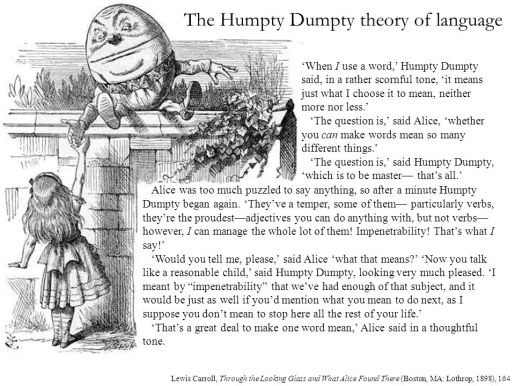




Alice In Wonderland was a basic text of the rock generation.
LikeLiked by 1 person
Go ask Alice- I think she’ll know… 🙂
LikeLike
There were a number of texts: Childhood’s End by Arthur Clarke, Stranger In A Strange Land by Heinlein, The Middle Earth Trilogy, Steppenwolf, Don Juan, a few others including Alice. If you hadn’t read and made them part of your brainwork you were pretty well out of it. I never got around to Buckminster Fuller although I have copy or two. Real fantasy land stuff.
LikeLike
Yes, it was like a brave new world in those days. I just love the symbolism presented in John lennon’s song, a master of the double entendre.
i read Alice in wonderland and through the looking glass in high school, I was never the same since! Haha- just teasing (kinda) but those surreal stories have a way of changing your perception of the world. They had Such an impact on modern culture.
LikeLike
Many thanks for the favorite on Vampyres. Lot of ego involved there.
LikeLike
Absolutely, I am still working through it now.
Is it a part of a larger series?
LikeLike
It is a novel. Takes place in 2018 in case you got confused on some details. What you read is Part 9 so there are eight earlier parts. There should be perhaps another 3 to five before I begin Volume II. Moving along nicely.
LikeLike
that’s great. I am going to link it here so readers can check it out too if they so desire.
If that’s not ok- Let me know and I will remove the link.
https://reprindle.wordpress.com/2016/07/01/the-vampyres-of-new-yorkthe-vampyres-of-new-york/
LikeLike
Thanks Diz, I appreciate it.
LikeLike
They Chewed
gnaw
gnaw gnaw
gnaw gnaw gnaw gnaw
gnaw gnaw gnaw gnaw
They Chewed !!!
LikeLike